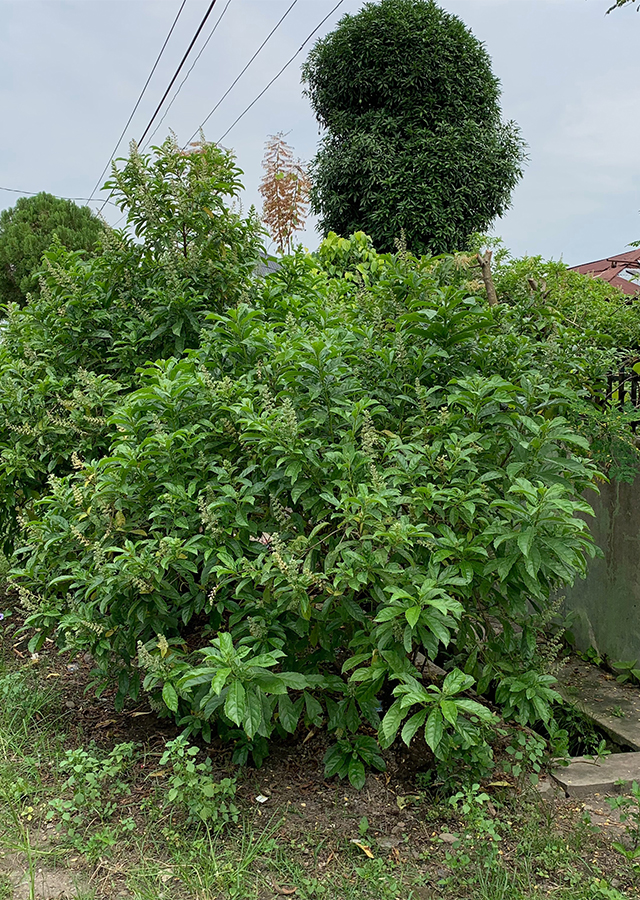Beatle Killer
Rotheca serrata (L.) Steane & Mabb.
Lamiaceae
Location in our garden
Principal



Synonym
Clerodendrum bracteosum Kostel.
Clerodendrum cuneatum Turcz.
Clerodendrum divaricatum Jack
Habitus
Shrubs. shrub or treelet, grows up to 4 m tall.
Part Used
Leaves
Seeds
Fruit
Roots
Twigs
Growing Requirements
Full Sunshine
Need Shade
Habitat
Forest
Shrublands
Overview
Beatle Killer is native to Eastern India, Sri Lanka and Malaysia. Widely distributed from Pakistan and India eastward to Central and Southern China, Indo-China, Thailand and Indonesia. The plant is harvested from the wild for use in traditional medicine and as food. Sometimes also cultivated as an ornamental hedge.
Vernacular Names
Senggugu (Indonesia), Tinjal tasek (Malaysia), Akkhee thawaan (Thailand), Ngọc nữ răng (Vietnamese), Sa heng (Laos), Nangal-bhanga, Bharangi (India).
Agroecology
This plant can be found in forests on mountain slopes, thickets, roadsides, and in valleys at elevations of 200-1,800 m. It is easy to grow in both tropical and warm-temperate climates.
Morphology
- Stem - relatively stout, mostly unbranched, nodes not annulate, bark grayish brown.
- Leaves - usually three at a node, alternate without stipules, elliptical to obovate, 7-22 cm × 3-8 cm, base acute to subcuneate, apex acute or short acuminate, margin serrate, glabrous on both surfaces, petiole 0.3-1.2 cm long.
- Flowers - Axillary cymes 3-5 cm long, terminal racemose panicle slender, calyx campanulate, tube 4-7 mm long, deeply dentate to truncate, bluish turning green, corolla zygomorhic, tube swollen, lateral lobes usually pale blue, stamens long exserted, blue, fruiting calyx somewhat accrescent.
- Fruits - drupaceous, glabrous, succulent, about 1 cm in diameter, 6-9 mm long, glossy emerald green turning dark purple or black when ripe with 1-4 pyrenes.
- Seeds - pyrenes, with or without endosperm
Cultivation
By seed - best sown as soon as possible. Germination can be erratic but usually takes place within 20-60 days at 20 °C. When large enough to handle, prick the seedlings out into individual pots and grow them on until large enough to plant out.
Chemical Constituents
Carbohydrates, phenolics, flavonoids, terpenoids, and steroids, hydrolysable tannins and flavonoids like Stigmasterol, α- spinasterol, luteolin, luteolin 7 - O glucuronide, apigenin, baicalin and scutellarin 7 - O glucuronide, β- sitosterol, ethyl cholesta - 5, 22, 25 trien - 3β ol, 5 hydroxy - 7, 4 - dimethoxy flavones, luteolin, apigenin, scutellarien and ursolic acid.
Traditional Medicinal Uses
- Studies have shown it as anti-inflammatory, anti-cancer, hepatoprotective, anti-diarrheal, and for its anti-microbial properties.
- The plant is commonly used in traditional medicine as a poultice for skin diseases, yaws, headache, leprosy, persistent fever, asthma, body aches, bronchitis, cholera, dropsy, eye diseases, inflammations, ophthalmia, rheumatism, malaria, fever, snakebite, tuberculosis, ulcers, and wounds.
- The root is considered antiemetic. It is used in medicine for treating fevers, rheumatism, and dyspepsia.
- The seeds are used to some extent for treating edema.
- The wood is considered a diuretic.
- The flowers are consumed during labour.
- The pounded leaves are applied externally in various prescriptions for cephalalgia, ophthalmia skin infections, rheumatism, and painful joints.
- A decoction of leaves and/or stem is used as a carminative, and to relieve fevers and chronic headaches.
- A decoction of the stem is used as an antimalarial and to relieve abdominal pain.
- A decoction of the fruit is given to relieve colic. Ripe and unripe fruits are chewed with the leaves of Piper betle for treating coughs.
- In India, this plant is used for the treatment of asthma, inflammation, wounds, snake bite, liver diseases, fever, and headache. The leaves are used to increase appetite and as an expectorant.
Part Used
Reference Sources
- Jayashree, J and Swaroopa, P.A. 2018. Rotheca serrata: An Overview, International Journal of Life Sciences, Special Issue, A10: 185- 190.
- Patel, J.J., Acharya, S.R., Acharya, N.S. 2014. Clerodendrum serratum (L.) Moon. – A review on traditional uses, photochemistry, and pharmacological activities. Journal of Ethnopharmacology, Volume 154(2): 268-285.
- Singh, K.M., Khare, G., Iyer, S.K., Sharwan, G and Tripathi, D.K. 2012. Clerodendrum serratum: A clinical approach. Journal of Applied Pharmaceutical Science, 2(2): 11-15.
- Upadhyay, S. and Koche V. 2019. Antioxidant Activity and Phytochemical Content of Clerodendrum serratum L. from Different Provinces of Chhattisgarh State, India. Asian Journal of Chemistry, 31(10): 2147-2151.
- van Valkenburg, J.L.C.H. & Bunyapraphatsara, N., 2001. Clerodendrum serratum (L.) Moon. In: van Valkenburg, J.L.C.H. and Bunyapraphatsara, N. (Editors): Plant Resources of South-East Asia No 12(2): Medicinal and poisonous plants 2. PROSEA Foundation, Bogor, Indonesia. Database record: prota4u.org/prosea




